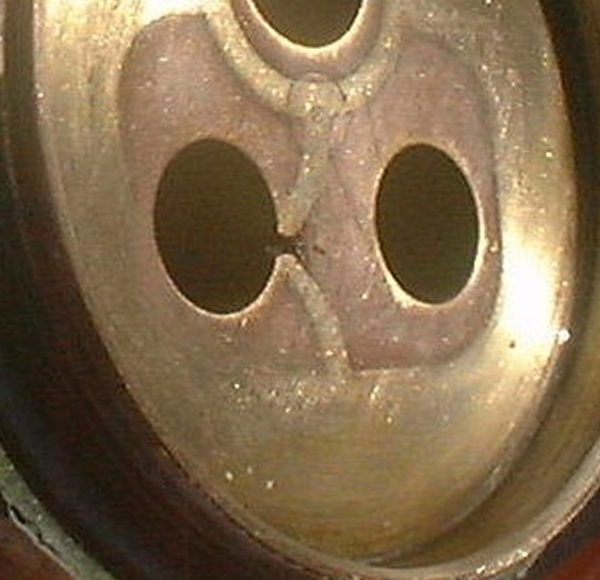| As stripped down, view of the
base of the tap onto which the cartridge is seated. The curved path of the central gasket is clearly visible, as is the small area of erosion caused by high speed water flow. The large hole is the outlet to the sink, the two smaller holes (towards the bottom of this photo) are the hot and cold supplies to the mixer cartridge. The two smaller holes at the top are merely location points for the cartridge. |
|
| Failure was caused by the
central web of the gasket moving sideways, thus allowing high pressure cold water to leak
into the hot side of the cartridge and hence into the hot supply pipe. The failure could have been caused by a one-off faulty cartridge (a fault in manufacture) or by faulty design. In this case, the thin upper web of the cartridge may have softened under the influence of hot water, allowing the gasket to move under the high sideways water pressure to which it is constantly exposed. For this to happen the type of plastic used must have been unsuitable - with a low softening temperature. |
|
| The cartridge base with the
gasket removed. The severe distortion of one of the supporting webs is clearly shown. This may have been a manufacturing fault or the web might have distorted gradually under the influence of hot water - but neither should have happened in a supposedly quality product! |
|
| The brass base, after cleaning
with very fine wet and dry paper. The more 'copper' colour of the area in contact with
water may be owing to slight dezincification of the brass. However, the major observations are the curvature of the central part of the gasket and the small 'pit' in the surface caused by erosion.This is what allowed high pressure cold water to leak into the hot supply pipe - and this caused the cold water storage cistern to overflow. Initially, the leak was small and the process took over eight hours - so if was rarely a problem as any usage of hot water anywhere in the house caused the level in the cold cistern to fall. However, as the erosion became more pronounced and the leak rate increased, the cistern would overflow after only a couple of hours - the leakage rate being tens of litres per hour - all flowing through this tiny erosion channel. |
|
 |
Close up of the erosion
channel. A constant flow of water under high pressure and at high speed has eaten away at
the brass. A new cartridge and gasket might have solved the problem - but these cost over £60 from Schock and the tap had other faults - including leaking O ring seals around the main swivel arm and the cartridge itself being increasingly stiff to operate. It is all a very poor advertisement for a 'quality' product. Photos taken 2008 |